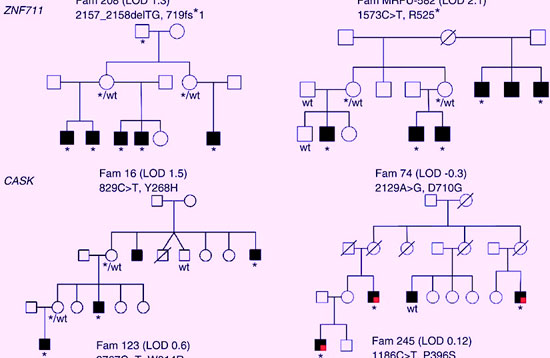Genome-wide association Studies (GWAS) identify genetic variants linked to traits or diseases. Expression Quantitative Trait Loci (EQTL) analysis reveals how these variations affect gene expression.
Delving into the realm of genetics provides insight into the complex interplay between our DNA and the traits we exhibit. Genome-Wide Association Studies are critical for mapping genetic variations, known as single nucleotide polymorphisms (SNPs), to specific health conditions or attributes.
On a more precise level, EQTLs help scientists understand the regulatory mechanisms that influence how much and when a gene is activated, which is referred to as gene expression. This relationship is essential because variations in gene expression contribute to the diversity seen in populations and individual susceptibility to diseases. Statistical techniques play a pivotal role in analyzing the vast amounts of data generated by GWAS and EQTL studies, assisting researchers in discerning patterns of genetic variation that hold biomedical significance. By integrating findings from GWAS and EQTL analysis, we can unravel the complex genetic architecture underlying various phenotypes and advance personalized medicine. The journey through this genetic landscape is propelling us toward a future where healthcare can be tailored to an individual’s genetic makeup, offering immense potential for diagnosis, prevention, and treatment strategies.
Genetics And Genomics
The fields of Genetics and Genomics are revolutionary. They unlock the mysteries of life at the most fundamental level. Understanding our genetic makeup paves the way for medical breakthroughs and personalized medicine. In this journey, we delve into the intricacies of how organisms inherit traits and how this knowledge shapes the future of healthcare and science.
Understanding Genetics
Genetics is the study of heredity and the variation of inherited characteristics. It focuses on how traits are passed from parents to offspring through genes. These units of inheritance control how we look and function. Here are the key elements of genetics:
- Gene: A segment of DNA that holds the code for a specific trait.
- Gene Expression: The process by which the information from a gene is used.
- Genetic Variation: Differences in DNA sequences between individuals.
Genetics uses statistics to analyze and predict how genes affect traits.
Introduction To Genomics
Genomics is the comprehensive study of an organism’s entire genetic material – its genome. Unlike genetics, which looks at individual genes, genomics examines all genes and their interplay. Here are some genomics components:
- Genome-Wide Association Study (GWAS): A method to find genetic variations linked to specific traits.
- Expression Quantitative Trait Loci (EQTL): Areas of the genome that influence gene expression levels.
Genomics requires powerful computational tools to analyze vast amounts of data.
Genome-wide Association Study
The realm of genetics unveils the complexities within DNA that make every creature unique. Among the tools scientists use to explore these intricacies is the Genome-Wide Association Study, commonly known as GWAS. This powerful research method scans genomes from numerous individuals to pinpoint genetic variations linked to specific diseases and traits. Understanding GWAS provides insight into the threads that weave the fabric of life.
What Is A Gwas?
A Genome-Wide Association Study or GWAS is a detective game at the genetic level. Researchers look across the complete DNA sequence of many people. They search for small variations or single nucleotide polymorphisms (SNPs). These SNPs could connect to various health conditions and physical traits. Essentially, GWAS helps find clues in human genetics that contribute to our well-being and characteristics.
Methods And Limitations
The methods behind GWAS involve comparing the DNA of two groups: those with the trait or disease and those without. Scientists use different statistical tools to show the relationship between specific genetic markers and the traits observed. They perform the following steps:
- Collect DNA samples from many participants.
- Use high-throughput genotyping technologies for analysis.
- Employ robust statistical software to manage and assess data.
Despite its strengths, GWAS isn’t perfect. Potential limitations include:
- False positives from statistical anomalies.
- Risks of misinterpretation of the genetic data.
- The need for very large sample sizes to detect effects.
Another challenge is that most GWAS focus on populations of European descent. This bias can lead to inaccuracies in understanding genetic factors across diverse human populations.
In conclusion, the genome is a complex puzzle, and GWAS is one of the tools used to decipher the genetic basis of health and disease. With each GWAS conducted, scientists inch closer to understanding the vast genetic variations that define the human species.
Gene
Genetics is a fascinating field, revealing the secrets of life. At the center of this field lies the gene. This tiny yet powerful entity is responsible for our traits and characteristics. Let’s dive into the world of genes and their intricate roles within our DNA.
Definition And Function
A gene is a DNA segment that contains the recipe for proteins. These proteins perform essential functions in our body. Genes are found on chromosomes and come in pairs.
- Genes carry instructions for our body.
- Each gene influences a particular feature or function.
- Genetic variation creates diversity in populations.
Types Of Genes
Our bodies contain thousands of different genes. These genes fall into various categories based on their functions.
| Type of Gene | Main Function |
|---|---|
| Structural genes code | e for proteins that form our body’s structures |
| Regulatory genes control | l the activity of other genes |
| Homeotic genes guide | e the body plan during early development |

Credit: www.scribd.com
Expression Quantitative Trait Loci (EQTL)
Expression Quantitative Trait Loci (EQTL) unravel the secrets of how our genes operate. These spots in our genome affect how genes turn on and off. They help scientists learn why people have different traits. Understanding EQTLs can lead to discoveries in health and disease.
Exploring Gene Expression
Exploring Gene Expression
Gene expression is the process where genes create proteins. These proteins decide how our bodies look and work. Each person’s genes are slightly different, leading to unique traits. Scientists study gene expression to find answers about these differences.
- Genes: The blueprint for our traits.
- Proteins: The workers building our body’s features.
- DNA: Holds the instructions for making proteins.
Expression patterns change based on several factors, including:
- Health.
- Environment.
- Stage of life.
Role of eQTLs in Genetics
Role Of EQTLS In Genetics
EQTLs control gene expression levels. They can be near the gene they regulate or far away. Researchers find EQTLs by looking at genetic data and measuring gene activity.
They use statistics to link gene activity with specific EQTLs. This shows how genes might cause different conditions. Understanding EQTLs could lead to new treatments for diseases.
Here’s what EQTL studies usually involve:
| Step | Process |
|---|---|
| 1 | Collect DNA and gene activity data. |
| 2 Analyze | e data with statistics. |
| 3 Find | d links between EQTLs and genes. |
Key Point: EQTLs are vital for understanding genetic variation in populations. By exploring QTLs, scientists can predict disease risk and responses to treatments.
Genetic Variation
Introduction to Genetic Variation
Genetic variation is the feast of differences in our DNA. It paints a unique picture of who we are. Our eye color, height, and even risks for certain diseases are traced back to these tiny variations. Let’s uncover the layers of genetic diversity that make each of us one-of-a-kind.
Understanding Genetic Variants
Understanding Genetic Variants
DNA is our genetic blueprint. A small switch in this code, and we see a world of change. These switches, known as genetic variants, are common yet special. Variants come in different forms:
- Single Nucleotide Polymorphisms (SNPs): A change in a single DNA building block.
- Insertions or Deletions (Indels): A DNA segment added or taken away.
- Copy Number Variations (CNVs): Sections of DNA that are repeated.
Each type has a role to play, influencing how genes work and how traits are expressed.
Impact of Genetic Variation on Health
Impact Of Genetic Variation On Health
Why does this matter for our health? Genetic variation is deeply tied to our well-being. It affects:
- Disease Susceptibility: Some variants increase our risk for diseases like diabetes or cancer.
- Drug Response: Variants can change how we react to medications, making some drugs more or less effective.
- Physical Traits: Traits like skin color and lactose tolerance are also rooted in genetic variation.
By studying these differences, scientists aim to craft personalized treatments and preventive measures. They can target the exact needs of an individual based on their genetic makeup.

Credit: www.spectrumnews.org
Statistics In Genetics
Genetics is not just about DNA and genes; it’s also deeply rooted in statistics. To unlock the secrets in our DNA, scientists use statistical analysis. This analysis helps explain how genes contribute to our traits. Let’s delve into the statistical tools used in genetic research.
Statistical Methods In Genetic Research
Geneticists rely on various statistical methods to analyze data:
- Chi-square tests: Help determine if observed data match expected distributions.
- t-tests: Compare two groups to see if they are statistically different.
- ANOVA: Stands for Analysis of Variance, used when comparing more than two groups.
- Regression models: Show the relationship between genetic traits and factors.
- Bayesian approaches: Calculate the probability of certain genetic outcomes.
Applications Of Statistics In Genetics
Statistics serve vital roles in different genetics studies:
- Genome-Wide Association Studies (GWAS): Find links between specific genes and traits.
- Gene Expression: Shows how certain conditions affect gene activity.
- Quantitative Trait Loci (QTL) mapping: Locates which part of the genome affects traits.
- Phylogenetics: Understands evolutionary relationships through genetic data.
Frequently Asked Questions For Genetics, Genome-wide Association Study, Gene, Expression Quantitative Trait Loci, Gene Expression, Genetic Variation, Statistics
What Does Genome-wide Association Study?
A genome-wide association study (GWAS) identifies genetic variants linked to specific traits or diseases by examining the DNA of many individuals.
What Are Genome-wide Association Studies Used ______?
Genome-wide association studies are used to identify genetic variants linked to diseases and traits.
What Is Genome-wide Quantitative Trait Loci Analysis?
Genome-wide quantitative trait loci (QTL) analysis identifies genetic variants associated with specific traits across the entire genome.
What Is Genome-wide Gene Expression Studies?
Genome-wide gene expression studies analyze the activity of genes across the entire genome to understand their function and regulation.
Conclusion
Understanding the complex tapestry of genetics is crucial for breakthroughs in medicine and biology. Genetics and its associated fields, like genome-wide association studies, unravel the mysteries within our DNA. Gene expression and the role of quantitative trait loci shed light on the minute differences that make us unique.
The interplay of genetic variation and statistical analysis continues to propel science forward. This blog post has highlighted the fascinating journey from genes to traits. Embrace the wonders of genetic research as it unveils the blueprints of life.

